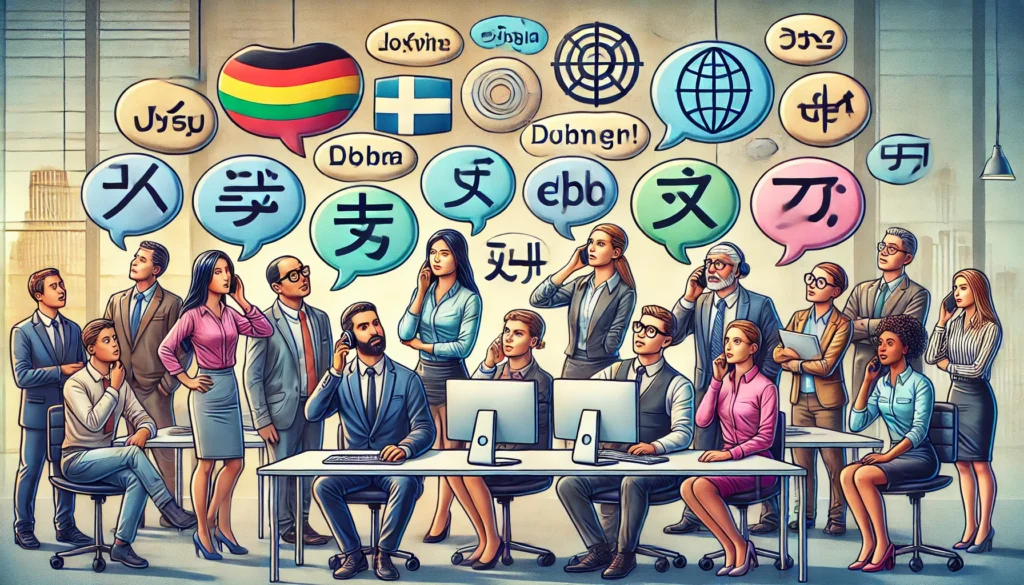Team culture – managing diverse, global teams

Previous article: Scaling workforce without losing quality
By enhancing team culture, promoting understanding, respect, and inclusivity, you'll build a productive, innovative, and engaged communication in global teams.
This article outlines best practices for managing communication in diverse teams operating across different geographical and cultural boundaries. It aims to provide actionable strategies to improve communication, build a cohesive team culture, manage varied work styles, and leverage diversity for innovation.
Staff augmentation for outsourcing companies 101
- Scaling workforce without losing quality
- Communication in teams and cross-cultural team management — you are here
- Building successful relationships with foreign customers
- Using data analytics in human resources for better decisions
- Data leakage prevention in hybrid teams
Understanding dynamics of the team culture
Cross-cultural teams consist of individuals from diverse backgrounds, each contributing unique perspectives in culture, language, work ethics, communication styles, values, norms, and education.
Challenges of communication in cross-cultural teams
Managing communication in teams with diverse culture involves navigating several significant challenges:
- Language barriers. Miscommunications due to language differences can disrupt workflows and lead to errors.

- Conflicting work ethics. Varied attitudes towards punctuality, hierarchy, teamwork, and accountability can cause friction.
- Cultural distance and culture shock. Differences in norms and values, along with adapting to new cultural environments, can overwhelm team members.
- Parochialism and ethnocentrism. Viewing one's own culture as superior can lead to discriminatory behaviors and decreased morale.
- Legal and ethical differences. Varying laws and regulations complicate management practices.
- Stereotypes and prejudices. These can lead to misunderstandings and discrimination, negatively impacting team dynamics.
Establishing effective communication
Asynchronous and synchronous tools for communication in teams
Effective communication tools, both asynchronous and synchronous, are essential for managing geographically dispersed teams.
- Asynchronous tools like email, project management software (Asana, Trello), file-sharing platforms (Google Drive, Dropbox), internal communication platforms (Slack, Microsoft Teams), and feedback tools (SurveyMonkey) facilitate non-real-time interactions.
- Synchronous tools like video conferencing (Zoom, Microsoft Teams), instant messaging (Slack), real-time co-authoring solutions (Google Workspace), and AI-powered transcription tools (Otter.ai) enable real-time interactions.
Integrating these tools maximizes efficiency, with platforms like Microsoft Teams combining multiple functionalities and automation tools (Zapier) streamlining workflows.
Language and cultural sensitivity
Use clear, inclusive language and understand cultural nuances by:
- Using gender-neutral terms and avoiding assumptions about relationships.
- Being mindful of cultural differences and avoiding idioms or slang.
- Using person-first language for disabilities and specific, accurate terms for race and ethnicity.
- Ensuring accessibility through plain language and sufficient color contrast.
- Being inclusive of diverse family structures and respecting religious practices.
- Using active voice and direct language, and avoiding age-related biases.
- Regularly updating language and being open to feedback.
Building a cohesive team culture
Inclusivity in diverse teams isn't just a nice-to-have. It's a must for innovation and engagement. A culture where everyone feels safe to contribute leads to the best outcomes.
Suman Aleti
Creating a cohesive team culture in a diverse and geographically dispersed environment requires deliberate effort and strategic planning. An inclusive team culture respects and celebrates diversity, fostering an environment where every team member feels valued and empowered.

Creating an inclusive team environment
To build a cohesive and inclusive team culture, focus on:
- Inclusive language and communication. Use gender-neutral terms, avoid assumptions, practice active listening, and encourage sharing of perspectives.
- Clear inclusion policies. Communicate a formal inclusion statement, set diversity goals, and provide inclusion training.
- Psychological safety. Foster an environment where team members feel comfortable speaking up, address exclusionary behaviors, and encourage diverse viewpoints.
- Inclusive leadership. Model inclusive behaviors, hold leaders accountable and provide training on inclusive leadership.
- Inclusive meetings. Ensure opportunities for all to contribute, use inclusive practices, and leverage technology for remote team members.
- Recognizing diversity. Acknowledge cultural holidays, highlight diverse stories, and recognize all contributions.
- Bias review. Audit HR processes for bias, use structured interviews, and ensure equal access to development opportunities.
- Employee resource groups. Support affinity groups and involve them in decision-making.
- Regular feedback. Conduct surveys and focus groups, and act on feedback to improve inclusion efforts.
By implementing these strategies consistently, you can create a team culture where all members feel valued, respected, and empowered to contribute their unique perspectives and talents. This inclusive environment leads to increased engagement, innovation, and overall team performance.
Team building activities
Effective team-building activities can help bridge cultural gaps and build trust among team members. Here are some ideas for virtual and in-person activities:
- Eat lunch together. This activity fosters bonding and teamwork.
- Play pub trivia. Encourages fun and teamwork.
- Start a book club. Develops relationships outside work tasks.
- Marshmallow challenge. Tests creative collaboration.
- Frostbite. Teaches communication and leadership skills.
- Classify this. Encourages creative thinking.
- Sales pitch. Practices public speaking and creativity.
- 3D printing. Promotes innovation and hands-on collaboration.
- Gastronomic race. Combines creativity and teamwork.
- Team haiku. Fosters creativity and concise communication.
When planning team building activities, it's important to:
- Choose activities aligned with your specific team goals (e.g., improving communication, fostering creativity).
- Consider the preferences and comfort levels of team members.
- Ensure activities are inclusive and accessible to all.
- Debrief after activities to reinforce learnings and connections made.
Effective team building can lead to improved morale, communication, and overall team performance when done thoughtfully and consistently.
Role of leadership in enhancing team culture via inclusivity
Leadership plays a crucial role in setting the tone for inclusivity and respect within the team. Key practices include:
- Lead by example. Model inclusive behaviors and treat all team members with respect.
- Create a safe environment. Foster a space for open sharing and implement clear anti-discrimination policies.
- Provide training. Invest in diversity training to understand unconscious bias and barriers to inclusivity.
- Set inclusive goals. Establish and monitor diversity goals, including them in performance evaluations.
- Empower diverse voices. Seek out and empower team members from underrepresented groups.
- Listen actively. Understand the experiences and perspectives of all team members.
- Promote cross-cultural competence. Provide resources for navigating cultural differences.
- Foster psychological safety. Encourage open discussions and address microaggressions.
- Practice open-mindedness. Value contributions from all backgrounds and challenge assumptions.
- Communicate benefits. Highlight how diversity drives innovation and better decision-making.
By consistently implementing these practices, you can create a culture where all team members feel valued, respected, and empowered to contribute their unique talents and perspectives. This inclusive environment leads to increased engagement, creativity, and overall team performance.
Managing and aligning different work styles
Understanding and adapting to different work styles in cross-cultural teams is key. It allows for a flexible, harmonious work environment where everyone can contribute their best.
Nasz Nazar
Different work styles refer to the diverse ways team members approach tasks, time management, communication, and collaboration. Recognizing and managing these differences is crucial in a cross-cultural team. Examples include:
- Structured vs. flexible. Preferences for clear schedules vs. adaptability.
- Individualistic vs. collaborative. Focus on personal achievements vs. teamwork.
- Direct vs. indirect communication. Clear, straightforward communication vs. nuanced, context-based communication.

Techniques for recognizing and managing different work styles
- Understand cultural dimensions. Use frameworks like Hofstede's to gain insights.
- Identify work style preferences. Use assessments like DiSC or Myers-Briggs.
- Promote cultural intelligence. Provide training on cultural awareness.
- Establish clear norms. Create guidelines for communication and decision-making.
- Adapt leadership styles. Flex leadership approaches based on cultural expectations.
- Leverage strengths. Assign tasks aligning with cultural strengths.
- Foster open communication. Create psychological safety for team members.
- Use structured methods. Implement processes like the nominal group technique.
- Address conflicts. Mediate cultural clashes with sensitivity.
- Celebrate diversity. Recognize and appreciate different work styles.
Training and development for cross-cultural competence
Cultural competence training
Regular cultural competence training enhances cultural awareness among team members. Training should:
- Increase awareness. Help team members understand their cultural biases.
- Improve communication. Teach strategies that account for cultural differences.
- Enhance norm understanding. Provide insights into social norms and work ethics.
- Develop conflict resolution skills. Equip team members with mediation techniques.
- Foster inclusivity. Encourage inclusive behaviors and celebrate cultural diversity.
Steps to implement training:
- Conduct needs assessment. Identify specific areas for improvement.
- Develop customized programs. Tailor training content to your team.
- Schedule regular sessions. Ensure continuous learning through workshops or online courses.
- Evaluate effectiveness. Gather feedback and adjust training as needed.
Enhancing team culture by promoting mentoring and coaching
Mentoring and coaching programs pair team members from different cultures to promote knowledge sharing and understanding. Benefits include:
- Facilitating knowledge sharing. Encourages exchange of cultural knowledge.
- Building mutual understanding. Provides a safe space for learning about cultural backgrounds.
- Supporting professional development. Offers guidance on navigating cultural challenges.
- Enhancing team cohesion. Builds a more cohesive and inclusive team culture.

Steps to implement programs:
- Identify mentors and mentees. Select culturally competent mentors.
- Provide mentor training. Focus on cultural competence and inclusive practices.
- Set goals and expectations. Define objectives for knowledge sharing and development.
- Monitor and support. Check in regularly and offer resources as needed.
- Evaluate effectiveness. Gather feedback to improve the program.
Leveraging diversity for innovation
I think most countries (these days) have people with strong technical skills, so it really depends on what country do you go with and if you have someone else manage finding and hiring the talent for you or if you want to do it all yourself.
u/emeffinsteve
Leveraging diversity fosters innovation and problem-solving. To capitalize on cultural diversity:
- Develop cultural intelligence. Provide training on cultural awareness and communication.
- Assemble diverse teams. Recruit and retain employees from varied backgrounds.
- Encourage knowledge sharing. Facilitate open dialogue and idea exchange.
- Adapt leadership styles. Promote inclusive practices and assign tasks based on cultural strengths.
- Implement structured collaboration. Use methods like the nominal group technique to ensure all voices are heard.
- Address conflicts. Mediate with cultural sensitivity and celebrate diversity.
- Provide flexibility. Adapt work processes to cultural preferences.
Managing communications across different time zones and team culture
Well, your project team spread across the globe, each member working from their own corner of the world. To create harmony amidst them, follow the next steps:
1. Build bridges with structure
You should establish clear pathways for communication, like dedicated Slack channels for quick chats, email threads for in-depth discussions, and shared project management boards for a visual overview. It's like creating a network of well-marked trails through a sprawling forest.
2. Sync up in real-time
Even with different time zones, you should carve out windows for everyone to connect in real-time. This could be a daily stand-up meeting where each team member shares their progress, or a weekly video conference to brainstorm ideas together. It's like finding that perfect spot where the sun shines for everyone, no matter where they stand.
3. Conversations beyond time
You should embrace tools like Google Meet or Microsoft Teams, where team members can leave messages, updates, and files for others to review at their own pace. It's like leaving notes in a bottle, ready to be discovered when the tide is right.
4. Learning to speak each other's language
You should host cultural awareness training sessions, inviting experts to share insights into different communication styles and work practices. Explore how a thumbs-up might mean different things in different cultures, and how to navigate these nuances gracefully. It's like learning a new language, opening doors to deeper understanding.
5. Building bridges with people
You should appoint dedicated liaisons, skilled communicators who can bridge the gaps between different time zones and cultures. They'll ensure everyone feels heard and understood, like translators who help different worlds communicate.
6. Mastering the clockwork of time
You should arm yourself with tools like World Time Buddy or Timezone.io, making scheduling meetings across time zones as easy as setting an alarm. Use calendar apps that automatically adjust meeting times to everyone's location, so no one misses a beat. It's like having a time-traveling watch that keeps everyone in sync.
7. Writing the story of your project
You should document every detail of your project, from requirements and decisions to progress updates. Use collaborative platforms like Confluence or Google Docs to create a shared narrative, accessible to everyone at any time. It's like weaving a tapestry where each thread represents a contribution, creating a beautiful picture of your progress.
8. Embracing the dance of flexibility
You should understand that life happens across different time zones. Encourage flexible work hours and communication timing, knowing that sometimes the best ideas come in the middle of the night. Offer compensatory measures for those who need to burn the midnight oil, ensuring everyone feels valued and respected. It's like a choreographed dance, where each step is taken in harmony with the others.
9. Always there, always ready
For critical projects, you should establish round-the-clock support teams, working in shifts to ensure that someone is always available to help, no matter the hour. It's like having a lighthouse that guides ships through the night, providing a beacon of support.
10. Bridging the language divide
You should employ translation tools and professional services to ensure that everyone understands each other, regardless of their native tongue. Tailor communications and materials to reflect the local context and language preferences of your diverse team. It's like building a multilingual library, where everyone can find the stories that resonate with them.
Conclusion
Effectively managing teams with different culture involves understanding varied work styles, fostering inclusivity, and leveraging diversity for innovation. Key strategies include cultural competence training, mentoring programs, flexible work policies, and culturally sensitive performance management. Encourage knowledge sharing and structured collaboration to enhance cohesion and productivity.
You as the leader should implement these best practices to enhance performance and improve the team culture, driving innovation and achieving outstanding results.
Next article: Building successful relationships with foreign customers
Egor Kaleynik
IT-oriented marketer with B2B Content Marketing superpower. HackerNoon Contributor of the Year 2021 Winner – MARKETING. Generative AI enthusiast.
Featured in: Hackernoon.com, Customerthink.com, DZone.com, Medium.com/swlh
More info: https://muckrack.com/egor-kaleynik